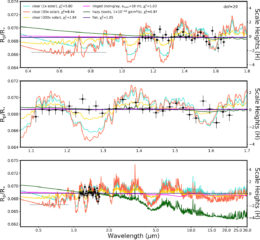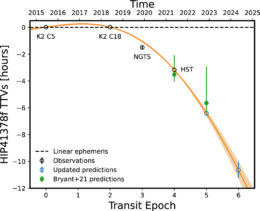Astronomers have discovered a curious exoplanet with an extremely low bulk density — nearly 15 times less dense than Jupiter and 60 times less dense than Earth. The first spectrum of this planet’s atmosphere gives clues to the cause of this unusual quality.
An Exceptional Exoplanet

Voyager 2 captured this shot of Neptune’s rings in 1989. Given its distance from its host star, HIP 41378 would likely have rings that are rocky like Neptune’s rather than icy like Saturn’s. [NASA/JPL]
Both possibilities are exciting, since we’ve only discovered a handful of super-puff planets, and we’ve yet to definitively detect rings around an exoplanet. Now, a team led by Munazza Alam (Carnegie Earth & Planets Laboratory and Center for Astrophysics | Harvard & Smithsonian) has collected the first near-infrared transmission spectrum of HIP 41378 f’s atmosphere to gain a better understanding of this unusual planet.

Transmission spectrum for HIP 41378 f (black circles) compared to model results (colored lines). The three panels show the same data and models over three different wavelength ranges. Click to enlarge. [Alam et al. 2022]
Puffy Planet, Rocky Rings, or Something Else?
Alam and collaborators used the Hubble Space Telescope to measure the light that filters through HIP 41378 f’s atmosphere as the planet makes its 19-hour transit across the face of its parent star. The team found that HIP 41378 f’s spectrum is nearly featureless, lacking the characteristic dips that signal absorption of light by molecules in the atmosphere.
Using one-dimensional atmospheric models, the authors were able to rule out a clear atmosphere rich in hydrogen and helium. However, they found that the planet’s nearly flat spectrum is consistent with multiple scenarios: HIP 41378 f might have an atmosphere exceptionally rich in elements heavier than helium, a layer of haze, or rings. In the ringed planet case, the authors calculated that HIP 41378 f’s true radius would be about 60% smaller than the current estimate, leading to a bulk density of 1.2 grams per cubic centimeter, which is roughly the density of Jupiter and Uranus.
Transit Opportunities
HIP 41378 f’s lack of spectral features doesn’t mean we can’t learn more about the planet’s atmosphere. Measuring the planet’s transmission spectrum at longer wavelengths might help distinguish between the possibilities, since a hazy atmosphere would induce transits of different depths at different wavelengths, while the presence of rings would produce less variation.The authors explored the possibility of observing HIP 41378 f with JWST and found that the telescope’s infrared instruments are sensitive enough to distinguish between the competing scenarios. With an orbital period of roughly 1.5 Earth years, there will only be a few opportunities to catch HIP 41378 f transiting in front of its parent star during JWST’s planned five-year mission. Alam and collaborators used the timing of the transit they observed to update the prediction for HIP 41378 f’s future transits; late 2022 and mid 2024 will bring new opportunities to study this enticing faraway world!
Citation
“The First Near-infrared Transmission Spectrum of HIP 41378 f, A Low-mass Temperate Jovian World in a Multiplanet System,” Munazza K. Alam et al 2022 ApJL 927 L5. doi:10.3847/2041-8213/ac559d

